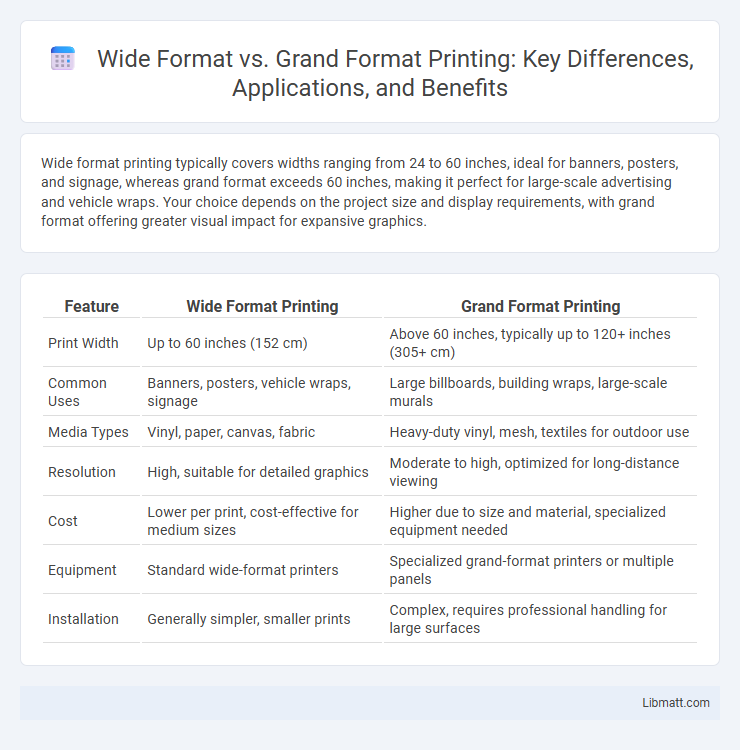Wide format printing typically covers widths ranging from 24 to 60 inches, ideal for banners, posters, and signage, whereas grand format exceeds 60 inches, making it perfect for large-scale advertising and vehicle wraps. Your choice depends on the project size and display requirements, with grand format offering greater visual impact for expansive graphics.
Table of Comparison
| Feature | Wide Format Printing | Grand Format Printing |
|---|---|---|
| Print Width | Up to 60 inches (152 cm) | Above 60 inches, typically up to 120+ inches (305+ cm) |
| Common Uses | Banners, posters, vehicle wraps, signage | Large billboards, building wraps, large-scale murals |
| Media Types | Vinyl, paper, canvas, fabric | Heavy-duty vinyl, mesh, textiles for outdoor use |
| Resolution | High, suitable for detailed graphics | Moderate to high, optimized for long-distance viewing |
| Cost | Lower per print, cost-effective for medium sizes | Higher due to size and material, specialized equipment needed |
| Equipment | Standard wide-format printers | Specialized grand-format printers or multiple panels |
| Installation | Generally simpler, smaller prints | Complex, requires professional handling for large surfaces |
Introduction to Wide Format and Grand Format Printing
Wide format printing typically covers print widths from 18 inches up to 60 inches, suitable for vibrant banners, posters, and vehicle wraps. Grand format printing extends beyond 60 inches, catering to massive prints like building wraps and large-scale billboards with enhanced color precision and durability. Both technologies utilize advanced inkjet systems to deliver high-resolution graphics on various substrates for advertising and signage industries.
Defining Wide Format Printing
Wide format printing refers to printing on materials larger than standard sizes, typically ranging from 18 inches to 60 inches in width, commonly used for banners, posters, and signage. It prioritizes high-resolution output on versatile substrates such as vinyl, fabric, and paper to ensure vivid graphics and durability. Grand format printing extends beyond wide format dimensions, supporting widths exceeding 100 inches, often used for large-scale billboards and vehicle wraps requiring robust ink technology for outdoor longevity.
What is Grand Format Printing?
Grand format printing refers to large-scale printing typically exceeding 100 inches in width, designed for massive visual displays such as billboards, building wraps, and large banners. This printing type uses advanced inkjet technology to produce high-resolution images on durable materials suited for outdoor and long-term applications. Your choice of grand format printing ensures impactful marketing visuals with exceptional size and detail that stand out in public spaces.
Key Differences Between Wide and Grand Format
Wide format printing typically covers media widths from 18 to 60 inches, ideal for banners, posters, and vehicle wraps. Grand format printing exceeds 60 inches, often reaching up to 100 inches or more, enabling production of large-scale signage, billboards, and event backdrops. The key differences between wide and grand format lie in media size capacity, printer type, and application scale, with grand format supporting much larger prints for extensive visual impact.
Applications of Wide Format Printing
Wide format printing specializes in producing large-scale graphics for outdoor banners, retail displays, vehicle wraps, and architectural blueprints, delivering vivid colors and high durability. This printing method supports your marketing strategies by creating eye-catching visuals that enhance brand visibility across various mediums. Industries such as advertising, construction, and event management rely heavily on wide format printing for impactful promotional and informational materials.
Common Uses of Grand Format Printing
Grand format printing is primarily used for large-scale advertising such as billboards, building wraps, and event backdrops due to its ability to produce vivid, high-resolution images on a massive scale. This printing technique is ideal for outdoor marketing campaigns, trade show displays, and large signage that require durability and UV resistance. Industries like retail, real estate, and entertainment rely on grand format printing to create impactful visual presentations that attract attention from a distance.
Print Quality: Wide vs Grand Format
Wide format printing typically offers high-resolution output suitable for detailed graphics and text, making it ideal for banners, posters, and signage up to 60 inches wide. Grand format printing extends beyond 60 inches, enabling larger-scale prints with slightly lower resolution, optimized for visibility from a distance rather than close-up detail. When choosing between wide and grand format, consider Your project's viewing distance and detail requirements to select the print quality that best fits Your needs.
Cost Considerations and ROI
Wide format printing typically offers lower upfront costs and faster turnaround times, making it ideal for small to medium-sized projects with limited budgets. Grand format printing, while more expensive initially due to larger equipment and materials, provides higher impact visuals that can enhance brand visibility and attract premium clients, potentially increasing your ROI. Evaluating project scale, audience reach, and long-term marketing goals will help determine the most cost-effective choice for maximizing returns.
Choosing the Right Format for Your Project
Selecting between wide format and grand format printing depends on the project's specific size requirements and intended application. Wide format typically refers to printing widths up to 100 inches, ideal for banners, posters, and indoor signage, while grand format exceeds this, suited for large-scale outdoor displays and building wraps. Consider factors like viewing distance, resolution needs, and installation constraints to determine which format delivers optimal visual impact and cost-efficiency.
Future Trends in Large-Scale Printing
Future trends in large-scale printing emphasize the convergence of wide format and grand format technologies, driven by advancements in high-resolution inkjet and eco-friendly UV-curable inks. Integration of AI-powered print management systems optimizes workflow efficiency and color accuracy for large-scale advertising and architectural applications. Increasing demand for sustainable materials and faster print speeds will shape the future landscape of wide and grand format printing industries.
wide format vs grand format Infographic

 libmatt.com
libmatt.com